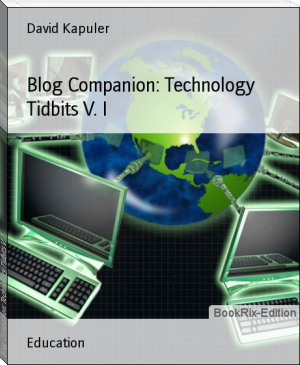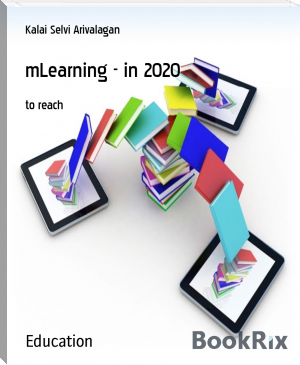INNOVATIONS IN SCIENCE, TECHNOLOGY AND MATHEMATICS EDUCATION IN NIGERIA by Ebele C. Okigbo, Nneka R. Nnorom, Ernest O. Onwukwe (the ebook reader .txt) 📖

- Author: Ebele C. Okigbo, Nneka R. Nnorom, Ernest O. Onwukwe
Book online «INNOVATIONS IN SCIENCE, TECHNOLOGY AND MATHEMATICS EDUCATION IN NIGERIA by Ebele C. Okigbo, Nneka R. Nnorom, Ernest O. Onwukwe (the ebook reader .txt) 📖». Author Ebele C. Okigbo, Nneka R. Nnorom, Ernest O. Onwukwe
Innovation in the teaching and learning environment
The school learning environment is critical because it provides opportunities for cognitive and psychological development of the child. Pierce (1994) opined that students’ outcomes such as subject matter achievement might be improved by creating classroom environment that are more conducive to learning. One of the reasons why science and technology are taught in Nigeria secondary schools is to enhances the scientific literacy of the citizenry, allow the students to understand their environment in its totality rather than in fragment, provide students at the basic level a sound basis for continuing science education either in specialist subject and also to allow the students to have a general view of the world of science and to serves as unifying factor for various science subjects. It is necessary for the learner to know these process through integrated approach of learning science (Federal Ministry of Education, 2014). The objective of science education in Nigeria is to expose all students without exception to science. This implies that every student should be exposed to science education irrespective of their location urban or rural. For science subjects, the proper learning environment is the laboratory irrespective of the location of the school. The laboratory setting is an innovative strategy that creates the opportunity for the development of skills in inquiry/problem solving and discovery in science learning. Innovative practices in teaching and learning science emphasize active participation of the learners in the learning process through series of activities within the confines of the laboratory and outside of it using the immediate and remote environment. Teaching the science subjects in the laboratory creates sense of responsibility in the students. Laboratory work is a range of activities ranging from true experimental investigations to confirmatory exercises and skill training, bridging the gap between abstract ideas and reality. When the science teacher takes the pain to teach practically the content of the curriculum with suitable practical exercise, the students would find fulfilment in studying science.
Innovation in instructional material usage
There are many innovative materials now available for use in teaching science subjects. Many books are also available today. There soft copies and hard copies. Many science text books have been published. Online resources are now available like Youtube, Open Educational Resources (OERs), video tapes, close circuit television, overhead projectors, simulations and computers are all innovations used in teaching science. Student engagement and understanding of materials is given more emphasis in today’s education over spoon feeding the facts. Many scholars and researchers have proposed advanced ideas and they claim that virtual teaching scenarios or simulations can help to build a better understanding of subjects amongst students. The aims of the teaching and study of sciences are to encourage and enable students to: develop inquiring minds and curiosity about science and the natural world. acquire knowledge, conceptual understanding and skills to solve problems and make informed decisions in scientific and other contexts (Ashley,2018)
Innovations in assessment of learning outcomes
The continuous assessment is an innovation in assessing the learning outcome of students. This came in as a provision of the national policy on education. Continuous assessment takes account of the entire learner’s performance in a given time in the school. Continuous assessment allows the full participation of the learner and enables the teacher to be flexible and innovative in selection of instructional content and methods in science teaching.
Classroom practices
Classroom practice, as a process, involves multiple agents and their interactions within the classroom as a system. The process can be manifested in diverse formats and structures, and its effectiveness can be influenced by numerous factors both internal and external to the classroom (Li, & Oliveira, 2015).Classroom practices indeed have a marked effect on students’ learning and achievement, this effect is at least as strong as that of student background. Nevertheless, research also suggests that certain teaching practices seem to be more effective than others for particular learning domains, educational levels and specific student sub-populations (Seidel & Shavelson, 2007). Using an inductive data analysis process, three major themes that characterized a science teacher identity emerged. These were the unique nature of science teachers’ identity; professional characteristics of science; and personal characteristics of science teachers (Keiler, 2018).Collaboration, flexibility, awareness of students’ needs, and advocates of equity and inclusion were identified as pivotal characteristics of science teachers. This study suggests that radically changing the learning environment can affect teachers’ identities and their approaches to teaching in predictable ways that can inform teacher education and professional development programs for science teachers, maximizing the success of teachers as they implement student-centered pedagogy (El Nagdi, Leammukda & Roehrig, 2018).Qualitative researchers have noted that the interaction that occurs between teachers and students in the classroom is greater than the sum of its parts. Students can leave the classroom with their knowledge and attitudes dramatically altered from what they were before they entered. Schools indeed matter, due to the overwhelming influence of the classroom practices of teachers on their students.
Conclusion
Innovative classroom practices foster sustainable development in a nation. Students learn in an environment that supports transfer of knowledge to everyday life activities. Teachers’ interaction with students stimulates their general and critical thinking abilities. The enormous responsibility on the teacher to bring about sustainable development in the nation and among her students, points to the fact that the teacher must embrace continuous learning and self -development. The teacher must avail herself of the innovation in curriculum structure, innovation in methodology, innovation in the teaching and learning environment, innovation in instructional material usage and innovations in assessment of learning outcomes to bring about sustainable development among the students. The level of preparatory education of the teacher determines the success of implementation of the student-centered innovative classroom strategies. This is where the government comes in to ensure adequate teacher education of the teachers, since no nation can rise above the teachers.
Implications for the science teacher
For sustainable development in the teaching of science and national development, the science teacher has enormous work and position to fulfil. The teacher is the implementer of the innovations; this implies the teacher has the duty/responsibility to ensure that the objectives of the innovations are met. Therefore, the teacher must on his own be aware of innovations in science and what he is required to do, be involved in the curriculum planning. The teacher must develop positive attitude towards innovations in science teaching and avail himself or herself with seminars and workshops for personal development and professional growth. This also implies that the teacher carries out adequate diagnoses of the students’ interest and ability.
Recommendation
The following recommendations are made:
The national curriculum objectives for schools’ subjects which have been in place should be assessed to ascertain to extent of achievement. There is need for assessment of curriculum implementation as well as the extent of implementation. In-service training should be organized for and given to science teachers periodically in the aspects of curriculum which are not efficiently implemented. Use innovative instructional strategies on should be included among the teaching activities of the science teacher.
The developing and implementing innovations are a complex activity which require knowledge skills and considerable time and variety of resources. The focus on sustainable development of the nation through education and science teaching need to be focus of the nation. Hence the need of the students should be known and a plan for innovation carefully drawn.
Feedback on the progress of the student should be monitored and possible modifications made when necessary. Diagnosis of students’ interest and ability that would foster creativity should be made early, channeling and teaching the students with innovations that will embrace sustainability.
The government as well as the teacher needs much attention ensuring that innovations are successful. Professional bodies like Science Teachers Association of Nigeria (STAN), Teachers Registration Council of Nigeria (TRCN), and others can serve as forum for equipping the teachers for the use of innovative instructional strategies.
References
Ababio, O.Y. (2013). New School Chemistry: Introduction to Chemistry Onitsha African
First Publishers plc.
Ashley,B. (2018). Innovation in science teaching. Retrieved 14th September 2019 https://www.edsys.in/innovative-science-teaching-methods/
El Nagdi M ,Leammukda, F. & Roehrig, G. (2018). Developing identities of STEM teachers at emerging STEM schools. International Journal of STEM Education, (5);36
Federal Republic of Nigeria (2004), National Policy on Education.4th edition. National Education Research and development Council.
Federal Republic of Nigeria, FME (2013). National Policy on Education 2013 and 4-year strategic plan for the development of the Education sector: 2011-2015 NERDC
Keiler, Leslie S. (2018).Teachers’ roles and identities in student-centered classrooms.
International Journal of STEM Education, (5)34
Li Y, Oliveira H. (2015).Research on Classroom Practice. In: Cho S. (eds) The Proceedings of the 12th International Congress on Mathematical Education. Springer, Cham
Mbah, H.N (2006). Introduction to Scientific Process. Nsukka: Chuka Education Publishers Limited
Naccino-Brown, R.; Oke, F.E.& Brown, D.P. (1982). Curriculum and installation: An introduction to methods of teaching. London: Macmillian Publishers.
Pierce, C. (1994). Importance of classroom climate for at-risk learners .Journal of educational research, 88(1); 23-30.
Seidel, T., & Shavelson, R. J. (2007).Teaching effectiveness research in the past decade: The role of theory and research design in disentangling meta-analysis results. Review of educational research, 77(4); 454-499.
Urebvu, A. (1990) Studies in science teaching: Methodology of science teaching. Benin City: Juland Educational Publishers.
Wehmeior, O.A (2010). Advanced Science and Technology for Poverty Eradication. Unpublished Work.
MULTIPLE PROJECTS WORK IN ANIMAL HUSBANDRY AND ACADEMIC PERFORMANCE OF SECONDARY SCHOOL STUDENTS FOR SUSTAINABLE NATIONAL DEVELOPMENT IN NIGERIA.
Dr. Ernest O. Onwukwe
Prof. Blessing Ijioma
Dr. Chibuike Nwachukwu
&
Sylvester Ozioko
Abstract
The very many negative notions of the Nigerian education system together with many seemingly plausible suggestions offered by the academic community must have resulted in reforms in the education industry generally and in the curricula in particular. One of such reform is the “re-introduction” of entrepreneurial education in the curriculum. Trade Subjects are made compulsory at the secondary school level. Every graduating secondary school student must offer at least one of the trade subjects like Animal Husbandry, Fishery, Garment Making, Data Processing, Tie and Dye, among others. Some scholars agree that the most important aim of introducing entrepreneurship education is to break the cycle of poverty that has ravaged the citizenry for decades. Since science as well as trade subjects are now offered in secondary schools, will effectively engaging students in projects enhance achievements and enrollment in a technology subject like Animal Husbandry? Quasi-experimental design was adopted to answer this question. Sample of 492 students were used. ANCOVA, t-statistics and chi square were used to test research hypotheses. Results show that students who carried out specific projects scored significantly higher mean values than those who did not, that involvement in more specific projects in the same school session enhanced students’ achievement than less specific projects. Increasing specific projects did not result in increased enrollments of students significantly among gender. It was recommended that Schools should involve students in experiential teaching and learning strategies like projects for sustainable national development.
Keywords: Animal Husbandry, secondary school, students, achievement, sustainable development.
Introduction
Presently, curriculum planners are using subject offerings to try and solve, not only today’s educational problems but to add such values that make national developments sustainable. National empowerments channelled through education are seen as sustainable. It is therefore not surprising that Nigeria’s National Economic Empowerment Development Strategy (NEEDS) was introduced to help chart the way forward in this direction. The National Planning Commission approaches this strategy through education (Abonyi & Okoli, 2009): “NEEDS recognizes education as a vital transformational tool and formidable instrument for socio-economic empowerment”. The application of entrepreneurial education is a vital component of NEEDS.
The educational reforms that will drive NEEDS agenda must necessarily
 The desire to acquire knowledge about the surrounding world and human society is quite natural and understandable for a person. Life is so developed that an uneducated person will never occupy a high position in any field. Humanity in its mass, and each person individually, develops objectively, regardless of certain life circumstances and obstacles, but with different intensity. The speed of development depends on the quality of training.
The desire to acquire knowledge about the surrounding world and human society is quite natural and understandable for a person. Life is so developed that an uneducated person will never occupy a high position in any field. Humanity in its mass, and each person individually, develops objectively, regardless of certain life circumstances and obstacles, but with different intensity. The speed of development depends on the quality of training.




Comments (0)